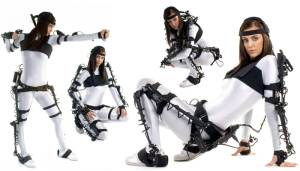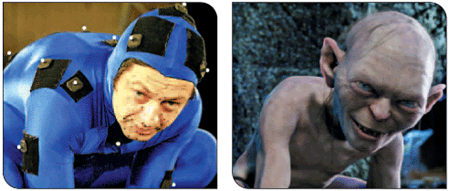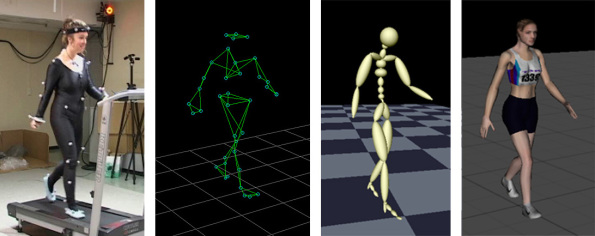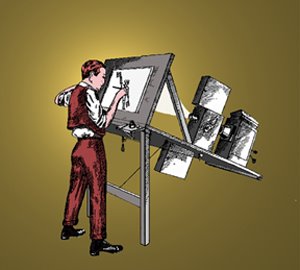Motion Capture is also known as Motion Tracking, or Mocap for short is 3D Animation. Motion Capture is a process in which recordings of human movement are translated into a digital code by filming sensors or every pivot point on characters body. One the video is captured it is then translated onto a 3D Model. (Oxford Dictionary, 2017)
Motion Capture technology has developed significantly since 1970. Performance capture is the term referred to when Motion tracking animates small features like figures, expressions and facial gestures. To portray, all this features more sensors hast to be used, and this makes motion capture process time-consuming. For example, the movie “Avatar” took 15 years to create. The whole purpose of this film was to record the performance of the characters and translate it into digital form.
![]()
![]()
![]()
Here I am embedding a behind the scene video of the famous movie “Avatar”, which I found while researching Motion Capture.
Mechanical Motion Capture:

This Motion Capture is a process by which the actors wear structured skeleton suit called as an exoskeleton capture system to track human joints and angles. This capturing system is the popular type of Performance capture and this because of the lowest price and availability in the field.
Electromagnetic Motion Capture:

This is the most specific type of the movement capture system relying on transmitters and receivers to track the body movement. An actor would wear a suit with several magnetic receivers in which transmitters would monitor and calculate body movements. The 20th-century Fox movie ‘The Lord of Rings’ used this technology for one of the lead roles of the creature “Gollum”.
Optical Motion Capture:

Optical Motion Capture system requires actors to wear reflective sensors over a tight Motion capture suit or their own clothes if they wish. The actor is asked to act while several cameras track the reflective pads. When cameras have the desired number of footage, it is then shared each other and translated to digital form.
History:
The system for capturing motion was first developed in the late 70’s, however, it was not recognised as a revolutionary animation technique till mid 80’s when it was eventually used for entertainment purpose. Inspired by Rotoscoping or Rotoscopy an ancient time-consuming technique was developed from early 90’s in which the animator will trace the movement frame by frame. Motion capturing technique was originally tested by the air force to track head movements of the fighter pilots by electromagnetic motion capture.
Below is the typical Rotoscope invented by Max and Dave Fleischer animators from 90’s who used rotoscoping infamous cartoons such as Betty Boop and Gullivers Travels.

Where is Performance capture or Motion Capture used?
Nowadays motion capture serves a broad range of purposes like pilot’s head movement tracking in the military, tracking of athletes in sports, determining injuries and how to treat them in medical applications, building human-like characters in animation, cartoon, games and films for entertainment and advertisement purpose.
For example, motion capture is used by worldwide car manufacturer Ford to help in developing a better product. Ford is the only company uses the same Motion capture software in its virtual engineering laps as Hollywood to create such motion pictures as Lord of Rings, Avatar and Polar Express.
- Research engineer Kevin Pline, outfitted with sensors that track the movement of his body, is seated in the vehicle compartment in the HOPS lab. The compartment can be reconfigured to represent a wide variety of vehicles and study comfort levels of design. (12/22/09)
- Technical Expert Ksenia Kozak studies the trajectories of research engineer Kevin Pline as he enters the vehicle compartment in the lab. Pline, outfitted with markers that track his body movement, is then questioned on the comfort of the compartment by Research Engineer Gianna Gomez-levi. (12/22/09)
- In the HOPS lab, a human test subject is outfitted with up to 50 motion capture sensors. He will then perform a series of movements while his trajectories are digitally recorded and loaded into a database. The database will be used to create digital human models. (12/22/09)
“Like in Hollywood movies, Ford hooks people with sensors to monitor how they move or react when they are interacting with the machines,” said Gary Strumolo, manager, Ford research and engineering. “Once we capture the motion, we create virtual human models that can use to run hundreds of tests that helps in understanding how people of all sizes and shapes interact with all vehicle designs. This is an efficient way of tomorrow’s engineering vehicles.” (Company, F 2017).
References:
-
Company, F. (2017). Ford Uses Hollywood Motion-Capture Software Behind ‘Avatar’ to Improve Vehicle Designs. [online] Prnewswire.com. Available at: http://www.prnewswire.com/news-releases/ford-uses-hollywood-motion-capture-software-behind-avatar-to-improve-vehicle-designs-79912032.html [Accessed 11 May 2017].
-
AZoSensors.com. (2012). Motion Capture Sensor Systems. [online] Available at: http://www.azosensors.com/article.aspx?ArticleID=43 [Accessed 11 May 2017].
-
The Hollywood Reporter. (2017). ‘Avatar’ house is motion-capture Giant. [online] Available at: http://www.hollywoodreporter.com/news/avatar-house-is-motion-capture-86549 [Accessed 11 May 2017].
-
Coldewey, D. (2014). Interview: Reuben Langdon, motion capture artist for Avatar. [online] TechCrunch. Available at: https://techcrunch.com/2009/06/23/interview-reuben-langdon-motion-capture-artist-for-avatar/ [Accessed 12 May 2017].
-
Hand, R. and Hand, R. (2009). The Art of Motion Capture in Avatar |. [online] VizWorld.com. Available at: https://vizworld.com/2009/12/art-motion-capture-avatar/ [Accessed 12 May 2017].
-
Sagar Lonkar. (2014). Types Of Motion Capture. [online] Available at: https://sagarlonkar.com/about-2/motion-capture/types-of-motion-capture/ [Accessed 12 May 2017].
-
Ranga (2013). Motion capture technology. [online] Slideshare.net. Available at: https://www.slideshare.net/anveshranga/motion-capture-technology-15980853 [Accessed 11 May 2017].

